Physical Address
304 North Cardinal St.
Dorchester Center, MA 02124
Cytologic examination is an integral part of gynecologic pathology. Many of the specimens presenting to the gynecologic surgical pathology service originate as the result of abnormal cytology examinations. Moreover, in many practices, the review of concurrent cytology and surgical pathology material is performed routinely for diagnostic and quality assurance purposes. Lastly, cytologic sampling of the peritoneal cavity is complimentary to pathologic evaluation in patient staging. Thus, it is reasonable to add a chapter specifically discussing this modality to this new edition of Gynecologic Pathology. This chapter concentrates on the most important and frequently encountered diagnoses in cervicovaginal cytology, arguably the single most important cancer screening success to date. As this is not intended to be a comprehensive review, the interested reader is referred to the third edition of the Bethesda System for Reporting Cervical Cytology , published in 2015, for detailed discussions and illustrations of the entities to be described in this chapter. This chapter ends with a brief overview of peritoneal fluid examination.
Since the original reports of clinical utility in the detection of cervical cancer by Papanicolaou and Babes in 1928, cervical cytology has become the most well-studied area in the field of cytopathology, with fine tuning to allow the detection of precursor neoplastic lesions of the lower genital tract. It is the detection, and hence eradication, of these precursor lesions that has driven the precipitous decline in cervical cancer rates (by as much as 70%) in countries where cytologic screening has been well adopted. Despite the remarkable success of cytology alone, the evolution of cervical screening programs has added other modalities, such as testing for and genotyping of human papillomavirus (HPV), the etiologic agent of the vast majority of lower anogenital tract cancers and precursor lesions.
Recently, the Food and Drug Administration has approved HPV testing for primary cervical cancer screening with cervical cytology only as a reflex test in certain situations. Moreover, the 2018 final recommendations from the US Preventive Services Task Force on cervical cancer screening recommend the following: in women 21–29 years, cytology screening every 3 years; in women 30–65 years, screening every 3 years with cytology alone or every 5 years with HPV testing alone or co-testing. This shift has led some to suggest that the role of cervical cytology in screening will disappear or be markedly transformed into an ancillary test only, whereas others suggest that cytology will remain as a frontline primary screen used in conjunction (co-testing) along with HPV detection. In this author’s opinion, it is safe to say that cervical cytology will remain a viable practice for the foreseeable future and, as important, because of its meticulous descriptions of normal and abnormal cells, it will remain the most effective modality for teaching the cytologic method (as it applies to the growing use of cytology in nongynecologic sites) to new students.
Cervical cytology specimens are obtained by directly scraping cells from the surface of the uterine cervix. A variety of sampling devices have been used in the past, but optimized modern techniques currently use devices designed to well-sample the exterior of the cervix (ectocervix), transformation zone, and upper portions of the endocervical canal. The transformation zone is where HPV initially infects the cervix and where the metabolically active metaplastic process allows for neoplastic transformation. Sampling of the transformation zone, which can be proximal or distal in the cervical anatomy, depending on various factors such as patient age and hormonal status, is therefore vital in the process.
There are devices that sample all three areas in a single pass (“broom” type), whereas others are designed to work in tandem (spatula for ectocervix and distal transformation zone and endocervical brush for proximal transformation zone and endocervical canal). Any of these methods, used appropriately, will provide adequate samples for examination. Specific adequacy requirements are detailed in the current third edition of the Bethesda Atlas and will not be covered here. The use of liquid-based collection (LBC) methods has been widely adopted in the United States and in other developed countries. Although there has been a “hot” debate about whether this method improves the detection of lesions, it is fair to say that LBC has standardized the morphologic appearance of specimens, improved adequacy rates, and increased screening productivity. In addition, LBC specimens are optimized for the use of automated screening methods and for molecular analyses, both of which have added to detection sensitivity and in some cases also to increased productivity.
The normal cervical squamous epithelium (ectocervix) is nonkeratinizing. It does not contain a granular layer (lacks keratohyaline granules) and does not show maturation to the level of parakeratosis or hyperkeratosis. As cytologic sampling only obtains cells from the top two to three layers, a cytologic sample from a woman of child-bearing age should show the presence of only superficial and intermediate squamous cells ( Fig. 21.1 ). Superficial cells show abundant polygonal cytoplasm, which is most commonly eosinophilic (a feature of high-molecular-weight or mature cytokeratin structure) but may also be basophilic. The nuclei are small and pyknotic. Intermediate cells, located just below the superficial cells, also have abundant polygonal cytoplasm, which is more commonly basophilic, a feature of a less-mature cytokeratin internal skeleton structure. Intermediate cell nuclei are larger than those of superficial cells and have a discernible finely granular chromatin pattern. Intermediate cell nuclei are easily found on cervical cytology specimens and are therefore routinely used to compare to the size of other cells’ nuclei, which, as noted later, is an important exercise in judging the neoplastic potential of abnormal cells. Squamous cells of less mature origin (in the child-bearing age group) are derived from squamous metaplastic reactions of the transformation zone. Squamous metaplasia represents a spectrum of change from immature cells with small amounts of round cytoplasm and high nucleus to cytoplasmic ratio (N:C), to mature metaplastic cells having rounded cytoplasm becoming more abundant with increasing maturation, but with larger nuclei than intermediate cells. A well-sampled transformation zone will show small numbers of squamous metaplastic cells intermingled with the dominant pattern of mature intermediate and superficial cells ( Fig. 21.2 ). In the peri- and postmenopausal periods, immature cells become more frequent in the specimen as the squamous epithelium becomes generally less mature, eventually leading to a predominance of immature squamous cells, a pattern referred to as atrophy ( Fig. 21.3 ).
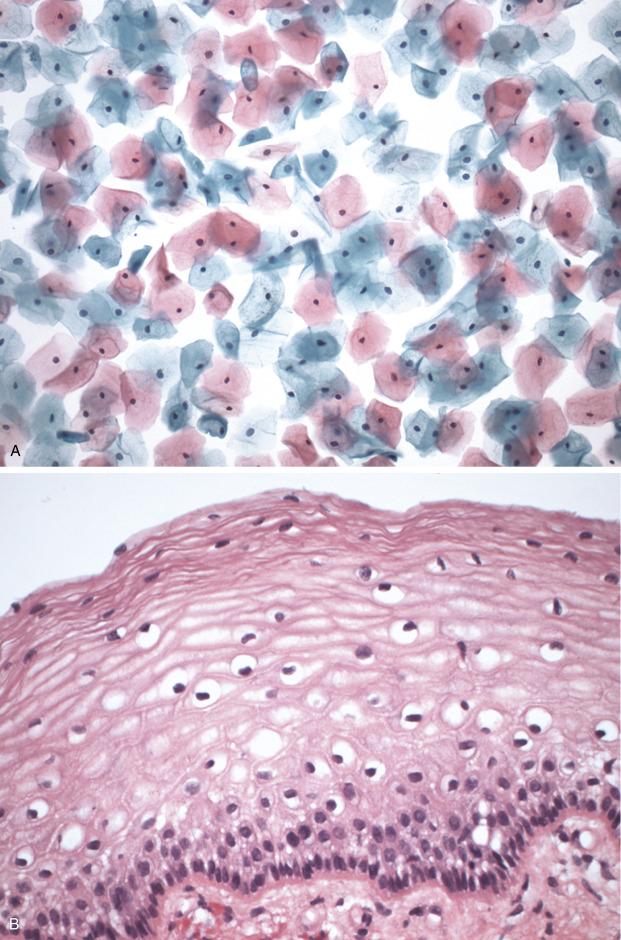
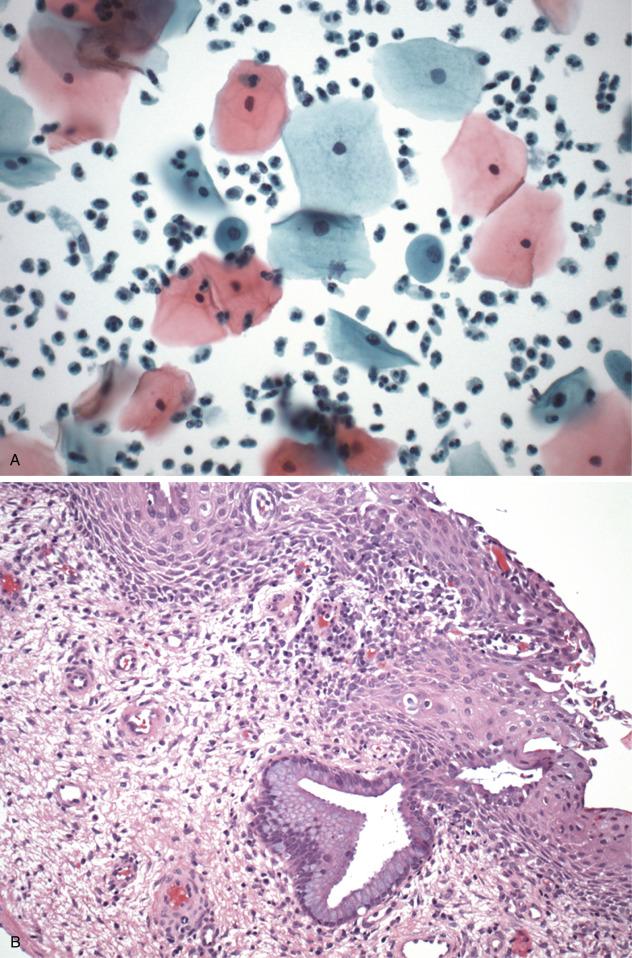
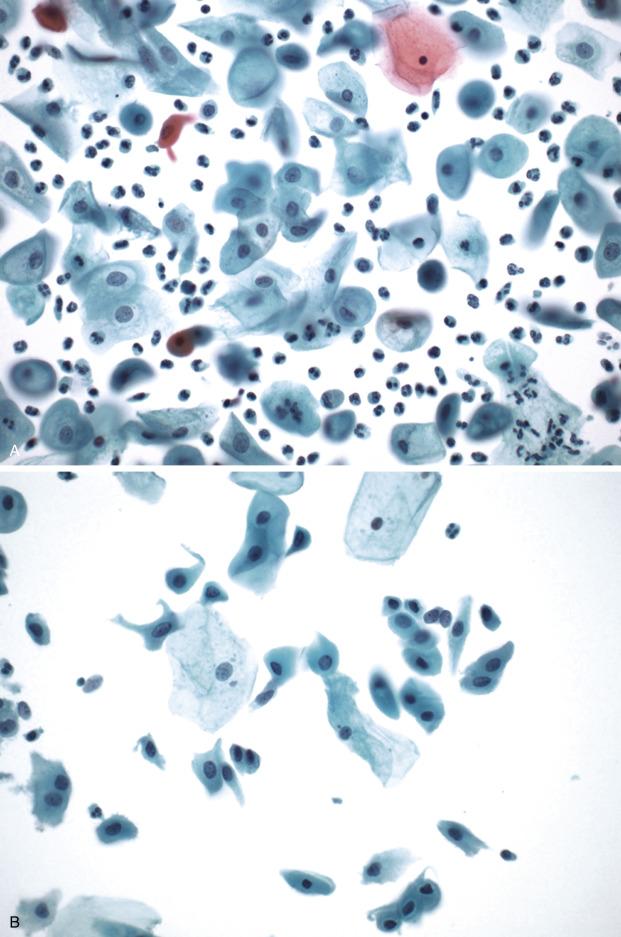
The endocervical canal adjacent to the transformation zone is lined by a simple columnar mucin-producing epithelium. In cytologic specimens, endocervical cells can be viewed from the side giving the classic histology recapitulation or the “picket-fence” appearance or on-end in a “honey-comb” configuration ( Fig. 21.4 ). The cells have nuclei that are slightly larger on average than an intermediate squamous cell nucleus, with some degree of nuclear size variability and distinctive “dot-like” nucleoli. The cytoplasm is frothy and clear (indicative of mucus) but may also be eosinophilic and granular. Higher in the endocervical canal, as the epithelium merges with endometrium, intermediate patterns between the two distinct epithelia emerge, including increased pseudostratification, smaller nuclei, and mucin-poor densely basophilic cytoplasm. In women over the age of 30 years, it is very common to see tubal metaplasia making up a significant proportion of the surface and deeper gland epithelium, leading to the presence of ciliated cells.
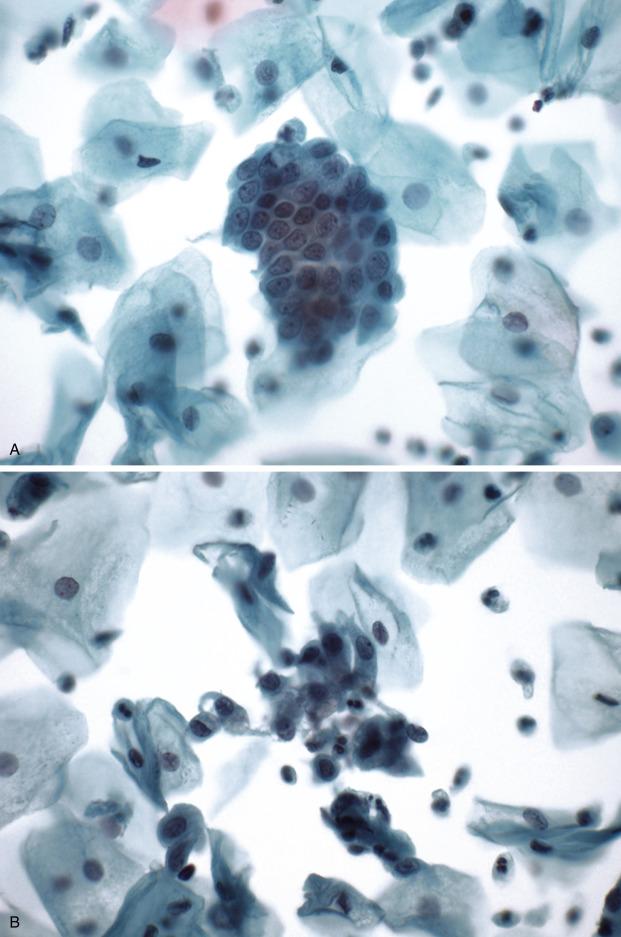
Endometrial cells are not routinely sampled by Papanicolaou (Pap) test collection devices and therefore appear only in their spontaneously exfoliated form, typically from menses or dysfunctional cycling. Occasionally, cells from cervical endometriosis or from the corpus in cases of post–cone biopsy samples will be directly sampled and their appearance can raise concern about neoplasia (discussed later). Exfoliated endometrial cells present as three-dimensional groups (having had time to “ball-up” while traveling in endocervical mucus). The nuclei are smaller than those of the intermediate squamous cell and often show densely granular chromatin. As most exfoliated endometrial cells are degenerating, it is common to see evidence of apoptosis in the groupings. A classic menstrual appearance is the so-called “exodus” pattern with three-dimensional balls of endometrial stromal cells surrounded by endometrial epithelial cells. These groups correspond to a similar appearance commonly noted in menstrual curettage specimens ( Fig. 21.5 ). Exfoliated endometrial cells are normal in the first half of the menstrual cycle in premenopausal women; when detected in the second half of the cycle, such cells may represent functional disorders. As such, endometrial cells in this population are not reported. However, in women over age 45 years, there is a proportionately increasing risk for an association with endometrial neoplasia. Therefore, the current recommendation is to report benign-appearing endometrial cells in this circumstance in the absence of history or when women are known to be peri- or postmenopausal. With such reports, clinicians should perform further investigations based on clinical risk factors.
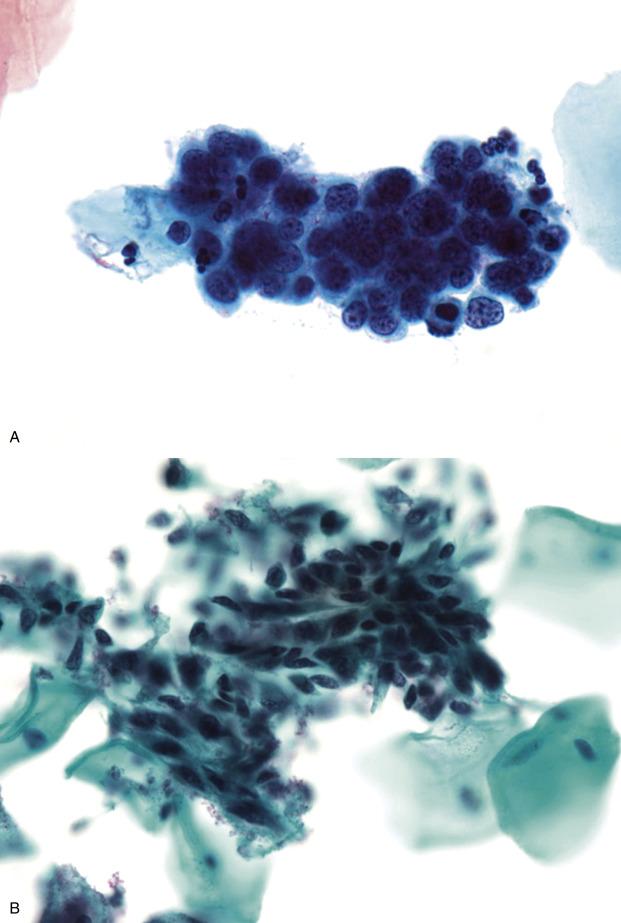
Become a Clinical Tree membership for Full access and enjoy Unlimited articles
If you are a member. Log in here